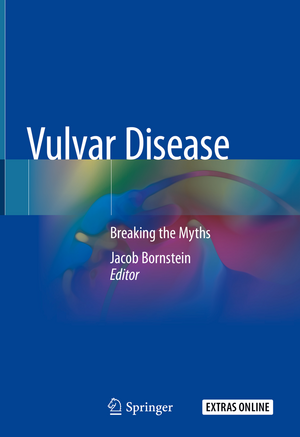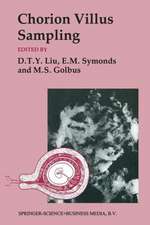Vulvar Disease: Breaking the Myths
Editat de Jacob Bornsteinen Limba Engleză Hardback – 29 apr 2019
The core chapters of the book are arranged in accordance with lesion presentation: red lesions, white lesions, patches and plaques, papules and nodules, erosions and ulcers, blisters, etc. For each lesion, the multidisciplinary management is fully explained, including clarifications of the role of gynecologists, dermatologists, physical therapists, pain specialists, sex therapists, and others. Clinical case presentations and numerous illustrations of treatment procedures are included, supplemented by informative online videos. A separate chapter is devoted to vulvar pain, which is increasingly becoming recognized as a growing problem. Here, again the past approaches are replaced with new paradigms. All of the authors are acknowledged experts in the field and the editor is a past president of the ISSVD. The book will be of value for all vulvar specialists and a wide range of other clinicians.
Preț: 1320.06 lei
Preț vechi: 1389.54 lei
-5% Nou
Puncte Express: 1980
Preț estimativ în valută:
252.62€ • 274.31$ • 212.20£
252.62€ • 274.31$ • 212.20£
Carte disponibilă
Livrare economică 01-15 aprilie
Preluare comenzi: 021 569.72.76
Specificații
ISBN-13: 9783319616209
ISBN-10: 331961620X
Pagini: 551
Ilustrații: XV, 412 p. 290 illus., 284 illus. in color. With online files/update.
Dimensiuni: 178 x 254 x 20 mm
Greutate: 1.32 kg
Ediția:1st ed. 2019
Editura: Springer International Publishing
Colecția Springer
Locul publicării:Cham, Switzerland
ISBN-10: 331961620X
Pagini: 551
Ilustrații: XV, 412 p. 290 illus., 284 illus. in color. With online files/update.
Dimensiuni: 178 x 254 x 20 mm
Greutate: 1.32 kg
Ediția:1st ed. 2019
Editura: Springer International Publishing
Colecția Springer
Locul publicării:Cham, Switzerland
Cuprins
Introduction (New terminology, Vulvar anatomy, principles of diagnosis and treatment).- Part I Skin-colored Lesions papules and nodules: Papillomatosis of the vestibule and medial labia minora (a normal finding; not a disease).- Molluscum contagiosum.- Warts (HPV infection).- Scar.- Vulvar intraepithelial neoplasia.- Skin tag (acrochordon, fibroepithelial polyp).- Nevus (intradermal type).- Mucinous cysts of the vestibule and medial labia minora.- Epidermal cyst.- Mammary-like gland tumor (hidradenoma papilliferum).- artholin gland cyst and tumor.- Syringoma.- Basal cell carcinoma.- Part II Skin-colored plaques: Lichen simplex chronicus (LSC) and other lichenified disease.- Vulvar intraepithelial neoplasia.- Part III Red lesions: eczematous and lichenified diseases: Allergic contact dermatitis.- Irritant contact dermatitis.- Atopic dermatitis).- Eczematous changes superimposed on other vulvar disorders.- Diseases clinically mimicking eczematous disease (candidiasis, Hailey-Hailey disease and extramammary Paget’s disease).- Lichen simplex chronicus (lichenification with no preceding skin lesions).- Lichenification superimposed on an underlying preceding pruritic disease.- Part IV Red lesions: red patches and plaques: Candidiasis.- Psoriasis.- Vulvar intraepithelial neoplasia.- Lichen planus.- Plasma cell (Zoon’s) vulvitis.- Bacterial soft-tissue infection (cellulitis and early necrotizing fasciitis).- Extramammary Paget’s disease.- Part V Red lesions: papules: Folliculitis.- Wart (HPV infection).- Angiokeratoma.- Molluscum contagiosum (inflamed).- Hidradenitis suppurativa (early lesions).- Hailey-Hailey disease.- Part VI Red lesions: nodules: Furuncles (“boils”).- Wart (HPV infection).- Prurigo nodularis.- Vulvar intraepithelial neoplasia.- Molluscum contagiosum (inflamed).- Urethral caruncle and prolapse.- Hidradenitis suppurativa.- Mammary-like gland adenoma (hidradenoma papilliferum).- Inflamed epidermal cyst.- Bartholin duct abscess.- Squamous cell carcinoma.- Melanoma (amelanotic type).- Part VII White lesions: papules and nodules : Fordyce spots.- Molluscum contagiosum.- Wart.- Scar.- Vulvar intraepithelial neoplasia.- Squamous cell carcinoma.- Milium (pl. milia).- Epidermal cyst.- Hailey-Hailey disease.- Part VIII White lesions: patches and plaques: Vitiligo.- Lichen sclerosus.- Post-inflammatory hypopigmentation.- Lichenified diseases.- Lichen planus.- Vulvar intraepithelial neoplasia.- Squamous cell carcinoma.- Part IX Dark colored (brown, blue, gray or black) lesions: patches: Melanocytic nevus.- Vulvar melanosis (vulvar lentiginosis).- Post-inflammatory hyperpigmentation.- Lichen planus.- Acanthosis nigricans.- Melanoma-in-situ.- Part X Dark colored (brown, blue, gray or black) lesions: papules and nodules: Melanocytic nevus.- Warts (HPV infection).- Vulvar intraepithelial neoplasia.- Seborrheic keratosis.- Angiokeratoma (capillary angioma, cherry angioma).- Mammary-like gland adenoma (hidradenoma papilliferum).- Melanoma.- Part XI Blisters: vesicles and bullae: Herpesvirus infections (herpes simplex, herpes zoster).- Acute eczema.- Bullous lichen sclerosus.- Lymphangioma circumscriptum (lymphangiectasia).- Immune blistering disorders.- Part XII Blisters: Pustules: Candidiasis.- Folliculitis.-.- Part XIII: Erosions: Excoriations.- Erosive lichen planus.- Fissures arising on normal tissue (idiopathic, intercourse related).- Fissures arising on abnormal tissue (candidiasis, lichen simplex chronicus, psoriasis, Crohn’s disease, etc.).- Vulvar intraepithelial neoplasia, eroded variant.- Ruptured vesicles, bullae and pustules.- Extramammary Paget’s disease.- Part XIV Ulcers: Excoriations (related to eczema, lichen simplex chronicus).- Aphthous ulcers; syn. Aphthous minor, aphthous major, Lipschütz ulcer.- Crohn’s disease.- Herpesvirus infection.- Ulcerated squamous cell carcinoma.- Primary syphilis (chancre).- Part XV: Skin-coloured edema: Crohn’s disease.- Idiopathic lymphatic abnormality (congenital Milroy’s disease).- Post-radiation and post-surgical lymphatic obstruction.- Post-infectious edema (esp. staphylococcal and streptococcal cellulitis).- Post-inflammatory edema (esp. hidradenitis suppurativa).- Part XVI: Pink or red edema: Venous obstruction.- Cellulitis.- Inflamed Bartholin duct cyst/abscess.- Crohn’s disease.- Mild vulvar edema.- Part XVII: Vulvar pain caused by a specific disorder: Infectious.- Inflammatory.- Neoplastic.- Neurologic.- Trauma.- Iatrogenic.- Hormonal deficiencies.- Part XVIII: Vulvodynia descriptors: Localized or Generalized or Mixed (localized and generalized).- Provoked or Spontaneous or Mixed (provoked and spontaneous).- Onset.- Temporal pattern.
Notă biografică
Professor Jacob Bornstein is Chairman of the Department of Obstetrics & Gynecology at Galilee Medical Center, Nahariya, Israel. He is a full Professor and Associate Dean at Bar-Ilan University, Faculty of Medicine, and immediate past chairman of the local institutional review board. Professor Bornstein is renowned for his vulvar and cervical research. He is the immediate Past President of the International Society for the Study of Vulvovaginal Disease (ISSVD) and is current chairman of the ISSVD terminology committee, which under his chairmanship recently published a new consensus terminology (developed by three societies: the ISSVD, ISSWSH, and IPPS) for vulvar pain and vulvodynia and the new ISSVD terminology of vulvar intraepithelial lesions. He has also been a member of the Executive Council of the International Federation of Cervical Pathology and Colposcopy (IFCPC) and recently chaired the IFCPC nomenclature committee, which published a comprehensive clinical and colposcopic terminology of the cervix, vagina, and vulva, as well as a terminology of different types of cervical excisional treatment. Professor Bornstein has served on the editorial boards of ten journals and has published over 200 scientific papers in peer-reviewed journals. He has recently been awarded the “Distinguished Scientific Award” by the American Society for Colposcopy and Cervical Pathology (ASCCP).
Textul de pe ultima copertă
This book offers comprehensive information on modern approaches to vulvar lesions, taking into account recent management recommendations and employing the consensus terminology of the International Society for the Study of Vulvovaginal Disease (ISSVD). Further, it breaks with past misconceptions and myths, and explains in detail the modern approach. The aim is to help clinicians perform the differential diagnosis of vulvar conditions and implement the new recommended treatments.
The core chapters of the book are arranged in accordance with lesion presentation: red lesions, white lesions, patches and plaques, papules and nodules, erosions and ulcers, blisters, etc. For each lesion, the multidisciplinary management is fully explained, including clarifications of the role of gynecologists, dermatologists, physical therapists, pain specialists, sex therapists, and others. Clinical case presentations and numerous illustrations of treatment procedures are included, supplemented by informative online videos. A separate chapter is devoted to vulvar pain, which is increasingly becoming recognized as a growing problem. Here, again the past approaches are replaced with new paradigms. All of the authors are acknowledged experts in the field and the editor is a past president of the ISSVD. The book will be of value for all vulvar specialists and a wide range of other clinicians.
The core chapters of the book are arranged in accordance with lesion presentation: red lesions, white lesions, patches and plaques, papules and nodules, erosions and ulcers, blisters, etc. For each lesion, the multidisciplinary management is fully explained, including clarifications of the role of gynecologists, dermatologists, physical therapists, pain specialists, sex therapists, and others. Clinical case presentations and numerous illustrations of treatment procedures are included, supplemented by informative online videos. A separate chapter is devoted to vulvar pain, which is increasingly becoming recognized as a growing problem. Here, again the past approaches are replaced with new paradigms. All of the authors are acknowledged experts in the field and the editor is a past president of the ISSVD. The book will be of value for all vulvar specialists and a wide range of other clinicians.
Caracteristici
Presents current knowledge on vulvar disease
Offers up-to-date guidance on diagnosis and treatment
Employs the contemporary terminology of the ISSVD
Includes informative illustrations and access to online videos
Offers up-to-date guidance on diagnosis and treatment
Employs the contemporary terminology of the ISSVD
Includes informative illustrations and access to online videos
















